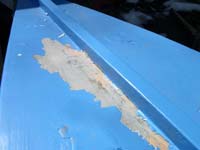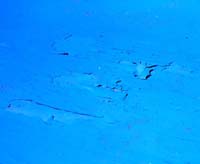Paint Failure
by Rob Rohde-Szudy
My light schooner project ran into a bit of a hitch last weekend. (That's late March 2005.)
I had painted the hull with latex in the unheated shop, but under a tent of plastic sheeting with space heaters keeping it mostly over 50 degrees F. Once the paint had cured for a week or so, I moved the boat outside and covered it with a sheet of black plastic. I didn't manage to cover a section of the bow, because the plastic was a little too small. I was hoping the house overhang would make up for it.
 It didn't. For about a month the boat sat with snow on it, and after the first brief thaw I took off the plastic to flip the hull over to work on some interior details. But some paint flaws caught my eye. The paint was loose right along the keel in the part that had been exposed. It was easy to peel of sheets of it in that section - paint and primer together - leaving it as seen in the photo at right.
It didn't. For about a month the boat sat with snow on it, and after the first brief thaw I took off the plastic to flip the hull over to work on some interior details. But some paint flaws caught my eye. The paint was loose right along the keel in the part that had been exposed. It was easy to peel of sheets of it in that section - paint and primer together - leaving it as seen in the photo at right.
I also noticed a couple sections where the very top layer had scaled, but there was still blue underneath. There were a couple sections like this under the covered part as well. (see the photo below)
I had filled a lot of the bottom with glass reinforced Bondo, so my first thought was that this paint would not stick to polyester. But that didn't make sense because there were sections of the sides and keel where it was sticking fine to the same polyester.
 I knew temperatures had been borderline, so maybe it was temperature related. The paint was OK on the keel, but not the bottom. Suppose the thinner bottom cooled faster at night and broke the adhesion? Nice theory, but the even-thinner sides were still holding the paint just fine.
I knew temperatures had been borderline, so maybe it was temperature related. The paint was OK on the keel, but not the bottom. Suppose the thinner bottom cooled faster at night and broke the adhesion? Nice theory, but the even-thinner sides were still holding the paint just fine.
OK, what was different there? The worst part was where the snow was sitting. Water shouldn't really cause the paint to lift. But what if the low temperatures had slowed the cure and it wasn't 100% polymerized yet? Maybe then some of the water could get under the coating during the day, then re-freeze at night! That would definitely lift any coating. Going a step further, perhaps the water didn't get as far into the coating in those patches underneath the plastic cover. Like they were from condensation instead of precipitation, so there was not enough water to get that deep. Then I realized that the parts most afflicted by the scaling under the plastic were also the most level parts, thus the most prone to collecting moisture.
So, I guess the lesson learned is to be completely certain that latex paint is cured fully hard before trusting it in extreme conditions of freezing wetness. This never happened to similar paint jobs under similar conditions in the past, BUT they had been out all summer, the latex slowly polymerizing to completion. This underscores how long it can take for latex to fully cure, and how much slower this is at low temperatures.
Fortunately, it's almost April and I have more plastic.
Rob Rohde-Szudy
Madison, WI

